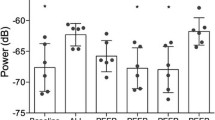Abstract
Purpose
The aim of this study is to assess how analysis of the spectral characteristics of lung sounds can help in detecting lung injury and subsequent recruitment as verified by computed tomography (CT).
Methods
Lung sounds were recorded at four locations (ventral and dorsal on right and left side) in six ventilated pigs before and after unilateral oleic acid-induced lung injury during sequential increase of positive end-expiratory pressure (PEEP) from 0 to 20 cmH2O. CT scans of the chest were used for comparison with lung aeration. Sound characteristics were compared by computer-aided analysis in the time and frequency domain as well as by clinicians.
Results
The presence of lung injury and its location were detected by substantial acoustic spectral components above 500 Hz (frequency) and −70 dB (amplitude). Application of increasing PEEP gradually reduced the pathological components as CT analysis verified recruitment. At 20 cmH2O PEEP there was no further tidal recruitment of injured lung and the pathological sounds had disappeared, rendering the lung sounds of the injured lung similar to those of the control lung. This was mirrored by the clinicians’ characterization of the sounds.
Conclusions
Computer-aided analysis of lung sounds is suitable for detection of pathological lung sounds and may guide in detection and recruitment of poorly/nonaerated lung.


Similar content being viewed by others
References
Pasterkamp H, Kraman SS, Wodicka GR (1997) Respiratory sounds: advances beyond the stethoscope. Am J Respir Crit Care Med 156:974–987
Piirilä P, Sovijärvi ARA (1995) Crackles: recording, analysis and clinical significance. Eur Respir J 8:2139–2148
Hadjileontiadis LJ, Patakas DA, Margaris NJ, Panas SM (1998) Separation of crackles and squawks from vesicular sounds using a wavelet-based filtering technique. COMPEL: Int J Computation Math Electr Electron Eng 17:649–657
Tolias YA, Hadjileontiadis LJ, Panas SM (1998) Real-time separation of discontinuous adventitious sounds from vesicular sounds using a fuzzy rule-based filter. IEEE Trans Inform Technol Biomed 2:204–215
Hadjileontiadis LJ, Panas SM (1997) Separation of discontinuous adventitious sounds from vesicular sounds using a wavelet-based filter. IEEE Trans Biomed Eng 44:1269–1281
Murphy RLH, Holford SK, Knowler WC (1977) Visual lung sound characterization by time expanded wave form analysis. New Engl J Med 296:968–971
Al-Jarad N, Strickland B, Lock S, Logan-Sinclair R, Rudd RM (1993) Diagnosis of asbestosis by a time expanded wave form analysis, auscultation and high resolution computed tomography: a comparative study. Thorax 48:347–353
Mori M, Morinari H, Shiraishi T, Koike S, Murao S (1980) Waveform and spectral analysis of crackle. Thorax 35:843–850
Gattinoni L, Pesenti A, Bombino M, Baglioni S, Rivolta M, Ross F, Marcolin R, Mascheroni D, Torresin A (1988) Relationships between lung computed tomographic density, gas exchange, and PEEP in acute respiratory failure. Anesthesiology 69:824–832
Vena A, Perchiazzi G, Giuliani R, Fiore T, Hedenstierna G (2006) Acoustic effects of positive end-expiratory pressure on normal lung sounds in mechanically ventilated pigs. Clin Physiol Funct Imaging 26:45–53
Vannuccini L, Earis JE, Helisto P, Cheetham BMG, Rossi M, Sovijarvi ARA, Vanderschoot J (2000) Capturing and preprocessing of respiratory sounds. Eur Respir Rev 10:616–620
Murphy RLH, Vyshedskiy A, Power-Charnitsky VA, Bana DS, Marinelli PM, Wong-Tse A, Paciej R (1997) Automated lung sound analysis in patients with pneumonia. Respir Care 49:1490–1497
Sovijarvi A, Vanderschoot J, Earis J (2000) Computerized respiratory sound analysis (CORSA) recommended standards for terms and techniques. Eur Respir Rev 10:585–649
Piirilä P, Sovijärvi ARA, Kaisla T, Rajala HM, Katila T (1991) Crackles in patients with fibrosing alveolitis, bronchiectasis, COPD, and heart failure. Chest 99:1076–1083
Gavriely N, Palti Y, Alroy G (1981) Spectral characteristics of normal breath sounds. J Appl Physiol Respirat Environ Exercise Physiol 50:307–314
Malmberg LP, Pesu L, Sovijarvi ARA (1995) Significant differences in flow standardized breath sound spectra in patients with chronic obstructive pulmonary disease, stable asthma and healthy lungs. Thorax 50:1285–1291
Räsänen J, Gavriely N (2002) Detection of porcine oleic acid-induced acute lung injury using pulmonary acoustics. J Appl Physiol 93:51–57
Räsänen J, Gavriely N (2005) Response of acoustic transmission to positive airway pressure therapy in experimental lung injury. Intensive Care Med 31:1434–1441
Alencar AM, Arold SP, Buldyrev SV, Majumdar A, Stamenović D, Stanley HE, Suki B (2002) Dynamic instabilities in the inflating lung. Nature 417:809–811
Hantos Z, Tolnai J, Asztalos T, Petàk F, Adamicza À, Alencar AM, Majumdar A, Suki B (2004) Acoustic evidence of airway opening during recruitment in excised dog lungs. J Appl Physiol 97:592–598
Acknowledgments
This study was supported by grants from The Swedish Medical Research Council (5315); The School of Anesthesiology and Intensive Care Medicine, Bari University, Italy; and The Center of Innovative Technologies for Signal Detection and Processing (TIRES), Bari University, Italy. The authors thank Agneta Roneus, Karin Fagerbrink, Eva-Maria Hedin (Hedenstierna Laboratory, Department of Medical Sciences, Uppsala University, Sweden), and Monica Segelsjö (Department of Radiology, Uppsala University, Sweden) for their valuable assistance during the experiments.
Author information
Authors and Affiliations
Corresponding author
Additional information
This article is discussed in the editorial available at: doi:10.1007/s00134-011-2292-3.
Electronic supplementary material
Below is the link to the electronic supplementary material.
Supplementary material 2 (MPG 15,718 kb)
Rights and permissions
About this article
Cite this article
Vena, A., Rylander, C., Perchiazzi, G. et al. Lung sound analysis correlates to injury and recruitment as identified by computed tomography: an experimental study. Intensive Care Med 37, 1378–1383 (2011). https://doi.org/10.1007/s00134-011-2291-4
Received:
Accepted:
Published:
Issue Date:
DOI: https://doi.org/10.1007/s00134-011-2291-4




